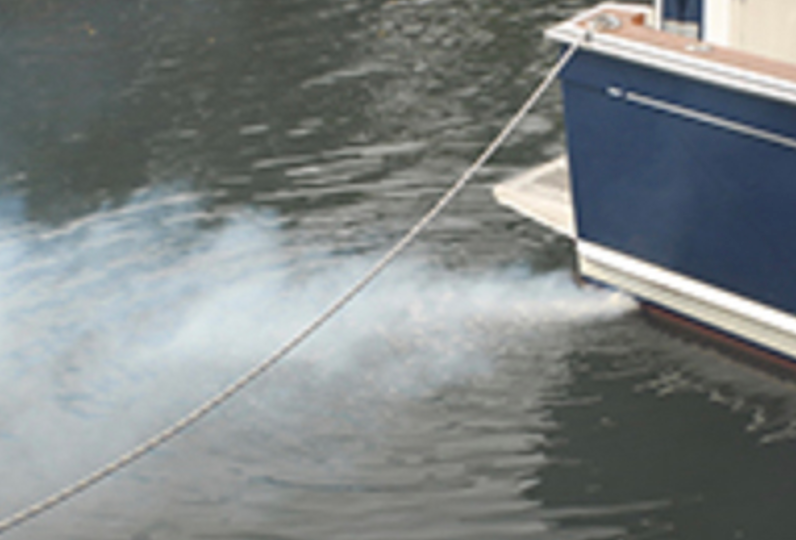Smoke Signals: What is Exhaust Telling You

Not everyone is mechanically oriented and that’s OK — as long as someone is willing to admit it. When we bring our boat to the mechanic for service and aren’t sure how to describe the malady, don’t be embarrassed. Put in terms that best describe what is going on and, more often than not, the mechanic will get the message. That being said, there are some messages we can pick up by looking at our engines’ exhaust.
Often, our engine is telling us things without us known. A favorite tool of many mechanics is looking at the exhaust. It gives us a wealth of information about what’s going on inside the engine as fuel is burned. The exhaust tells if the engine is getting enough fuel or too much, too early or late. It tells us if the explosions are happening at the right time and if all the elements of smooth running are aligned. It rarely tells us how to fix the problem but it will point us in the right direction.
When we talk about exhaust, we’re looking at the by-products and left-overs of the combustion process. On a diesel engine, this can most readily been seen in the exhaust gases. On a gasoline engine, we can get a bit closer by looking at the spark plugs in combination with the exhaust.
Diesel Engines

With a diesel engine, no apparent exhaust means all is running well. A diesel’s exhaust should be colorless, with a slight trace of a diesel smell.
White smoke indicates that raw diesel fuel has come through the exhaust intact and unburnt. There are a few reasons that this might occur:
- Faulty or damaged injectors — injecting too much or too little fuel at the wrong moment in the combustion cycle.
- Incorrect injection timing — a worn, damaged or mis-aligned timing gear.
- Low cylinder compression — leaking or broken valves or worn cylinder walls/pistons, or piston rings.
- Water entering the combustion space — caused by broken head gaskets or damaged cylinder heads.
- Fouling deposits or cylinder glazing can cause white smoke at start-up, which then disappears as the engine warms up
Blue Smoke indicates that oil is being burnt. Oil can enter the combustion chamber in a few ways:
- Worn valve guides or seals.
- Cylinder, piston ring or ring-groove wear.
- Stuck or sticking piston rings.
- Faulty seals in the turbocharger.
- Incorrect grade of oil (oil is too thin).
Blowby happens when compressed air and fuel in the cylinder bore are greater than the pressure in the oil pan. Fuel leaks past piston rings and into the crankcase. When the pressure becomes too great, it must escape and finds any route to ‘blow by’ seals and gaskets. In most cases this is due to worn (or broken/missing) piston rings. It’s identified by:
- Rough idling or misfiring.
- White smoke billowing from the valve cover or the oil fill tube.
- Diluted oil (by diesel fuel).

Gasoline Engines
In a gasoline engine, the spark plugs tell us similar diagnostic stories. The spark plugs are threaded into the top of the engine’s cylinders. Air running into the engine and exhaust gases running out pass by the spark plugs. How controlled explosions inside the engine occur can be evidenced on the tip of the spark plug.
Spark plugs are specific to their application: They must be the right length (to sit at the correct depth in the combustion chamber) and the gap between the electrode and the tip must be the correct distance to maximize the amount of electrical current that jumps across that gap. Engine problems can affect spark plug performance and spark-plug maintenance can affect engine performance. Here are a few spark plug conditions and their performance indicators:
- Dry or wet fouling: The spark plug end is covered (fouled) with debris — wet or dry. This could be unburnt fuel, water or exhaust deposits.
- Overheating: the insulator tip has a melted or glossy look from the buildup of hot engine deposits
- Deposit buildup: The accumulation of deposits can indicate that oil is leaking or the fuel is of a poor quality
- Melting — When an abnormally high current arcs across the spark-plug tip, it can melt and effectively weld the electrode to the tip
- Gummed — old fuel can build up and gum the gap between the electrode and tip, preventing it from functioning.
Engines can tell us a lot. The look, feel, smells and sounds that are evidenced during normal operation (as well as when problems happen) can tell us about the engine’s health. Don’t be shy to let your mechanic know what you’re hearing, seeing or smelling. These diagnostic signs can help in many ways. Learning some of them can also alert you to problems, and let you tackle maintenance items to prevent problems in the long-run.